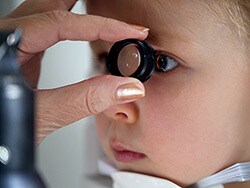Visual Outcomes and Complications of Type I Boston Keratoprosthesis in Children: A Retrospective Multicenter Study and Literature Review
Fung SSM, Jabbour S, Harissi-Dagher M, et al
Ophthalmology. 2018;125:153-160 Abstract
Viewpoint
As one of the surgeons performing the most corneal transplants in children at Wills Eye Hospital for the past many years, I am especially eager to learn about anything that will improve the fairly mediocre state of affairs in pediatric keratoplasty.
Corneal transplantation in children is technically difficult, with increased risk for extrusion of the intraocular contents during surgery. Postoperative follow-up care is challenging at best. Children often do not complain when something untoward is going on in the eye, such as a loose suture or corneal abrasion, so it persists much longer without treatment than in most adults—often with untoward results.
Just examining the eye of a baby or child in the office is rather difficult, and we rarely get the good view that we do in adults. We may need to perform an examination under anesthesia just to get an adequate look at the eye. When sutures need to be removed, the child needs to be put under general anesthesia. This can be scheduled easily for routine suture removal, but when a suture loosens or breaks and needs to be removed right away, it is not as simple to schedule an emergent trip to the operating room. Grafts in babies and children also reject more commonly than in adults.
All of this is background as to why corneal surgeons have been looking for a better way to do corneal transplants in children.

Boston keratoprosthesis works fairly well in many adult eyes where a corneal transplant is not expected to remain clear for very long. In fact, many adult patients feel as if it is a miracle. Wouldn't it be great if they worked as well in children? There would be more rapid visual recovery than with a standard corneal transplant and ideally would decrease the risk for amblyopia. There also would not be any graft rejection.
For those reasons, Boston keratoprosthesis started to be performed in babies and children, including at Wills Eye Hospital. However, many, if not most, corneal surgeons began to realize that results in children were not as good as in adults, and they became more hesitant to perform this procedure in very young patients.
Fung and colleagues[1] should be congratulated on publishing their disappointing results of type I Boston keratoprosthesis implantation in children, something we are all somewhat reluctant to do. Yet, it is very important to share these types of outcomes with the ophthalmic community. Their results were so poor that they have stopped performing this procedure in children.
Aquavella and colleagues[2,3] have had a better experience with Boston keratoprosthesis in children. At Wills Eye Hospital, we also have had some children do well with a Boston keratoprosthesis but are wondering why. Do some diagnoses do better than others? Does age make a difference? Fung and colleagues' study was fairly small, but they did not find a large difference in outcomes between diagnoses or age at time of surgery.
As we know, standard corneal transplantation in children has a very guarded prognosis. We need to continue to look for a "better way" to improve the vision of children with corneal opacities. Just as the results of Boston keratoprosthesis improved over time in adults, we need to continue to work on improving the results in children.
Medscape Ophthalmology © 2018 WebMD, LLC
Any views expressed above are the author's own and do not necessarily reflect the views of WebMD or Medscape.
Cite this: Christopher J. Rapuano. Disappointing Results of Boston Keratoprosthesis in Kids - Medscape - May 16, 2018.










Comments